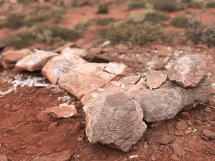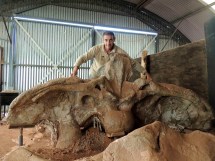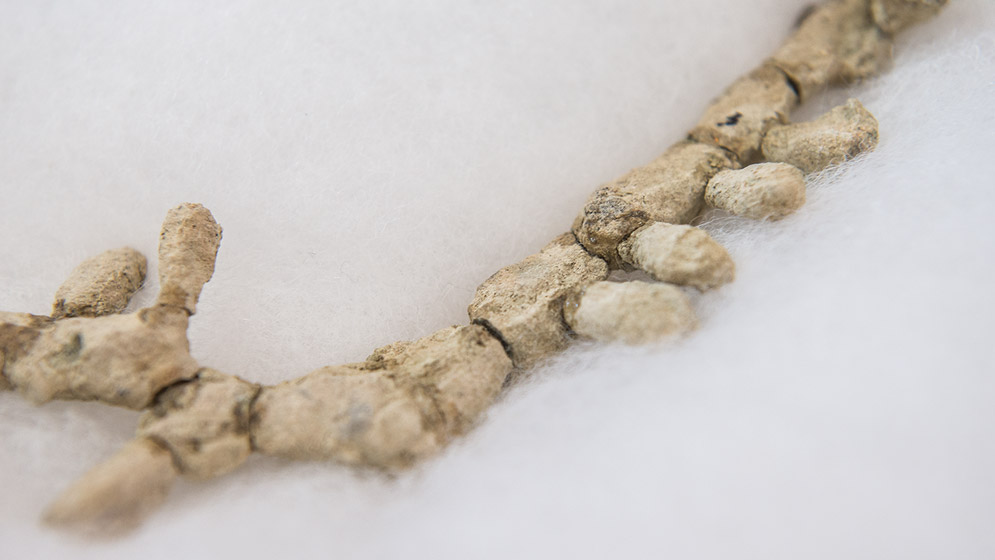In the Patagonia of Argentina are the oldest records of primitive bees. These are trace fossils dating from the Cretaceous Period of the Mesozoic Era, around 125 and 80 million years ago.

The most emblematic fossils were located in the vicinity of the town of Sarmiento, in the center-south of the province of Chubut.
There, a team of CONICET researchers reported having found several 100-million-year-old bee nests.. They can be assigned to the bee tribe Halictinia group that lasts to this day.
The research was published in 2020 in the journal PLOS ONE and drew the attention of international media. Even National Geographic called the finding “the oldest evidence of modern bees.”

El lugar del hallazgo fue el Cañadón Tronador en la provincia del Chubut
“We went looking for simpler things in the field and we came across this discovery, which nobody could believe. It was the last day of the campaign, so we were left with only that fossil. The following year another 20 appeared in the same sector, they were all similar. They were complex structures full of cells, ”he commented to BLACK RIVER Marcelo Krause, leader of the research, who works as a professor at the University of Río Negro and a researcher at the Egidio Feruglio Paleontological Museum in Chubut.

Since some modern species build underground nests that look almost identical to those found, the researchers immediately thought it was a class of halicthids (the family that brings together pollinators). And so it was that they decided to name the species that would have inhabited these soils as Cellicalichnus krausei, in homage to its discoverer.
One of the most important steps was to corroborate the age of the fossilized structures. To do this, the paleontologist contacted experts from the United States, who used a methodology based on the consolidation of volcanic ash present in the soil..
“What we did was locate a sample and I contacted people from the United States to participate in the research and help me with the analysis. There we got the magical age of 100 million years,” she specified.
According to Krause’s words, the existence of these fossils allows us to go back the world record of ancient bees some 40 million years in time, contributing significantly to evolutionary history.

“There are records of bees in various parts of the world. Of this particular ichnogenus, which presents a tube full of cells around it, it has not yet been found anywhere else. They do find other, simpler structures,” the scientist said during the interview.
Importance of the finding
Bees have a fundamental role in current ecosystems because they are the main pollinators. Thus, they form a fundamental link in the reproduction of plants, the development of seeds and fruits.

Sorpresa. Así se conserva el nido de abejas de hace 100 millones de años.
It is likely that bees have also been key in the evolutionary chain as promoters of the diversification of dicotyledons, the group that brings together flowering plants.
Hence its importance to learn more about its history, to understand the development of the current vegetation. In addition to contributing to its preservation.
“It is believed that they were triggers for the appearance of flowering plants and their rapid diversification. Some flowering plants had appeared before, but they were the fewest. When these pollinators are there, it is like it is amplified and that is why later you have a biotic revolution at the floristic level. Most of the flowering plants appear after 100 million years”, detailed Marcelo Krause.
Studies indicate that bees appeared at the end of the Lower Cretaceous (123 million years), in tune with the expansion of dicotyledonous species.
But there were no records to support these theories, until the discovery of trace fossils in Chubut.
These nests also allowed establishing a record on the behavior of some of these insects, modalities that continue to this day.
“We have an advantage when studying these fossil traces, because insects usually form structures that recur over time, which allows us to assimilate their behavior with current bees,” said the researcher.
This same way of acting is what would have facilitated the protection of the nests in perfect condition.
“Due to the very biology of bees and their need to preserve eggs, they make a structure in such a way that it ends up being impermeable to water. It’s what makes it easier to preserve as fossils.”Silvina de Valais, a CONICET researcher who works at the Institute for Research in Paleobiology and Rock Geology, added accordingly.
To comment on this note you must have your digital access.
Subscribe to add your opinion!
Subscribe
